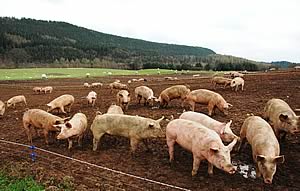 |
|||||||||
|
|||||||||||||||||||
|
|
Avoid
Temptation
to Retain Old Sows 26/10/07 The pig industry is once again caught up in the varying restrictions imposed to prevent the spread of notifiable diseases.
Whilst this is having serious effects on some producers who would normally be moving weaners, the effect on breeding herds is furthermore indirectly serious. Reports from NADIS surveillance veterinary surgeons indicates that cull sows are accumulating on farms. The sequence of restriction on farms has been:
Therefore, the combined effect of restrictions and low prices is encouraging cull sows to be retained and in many cases re-served. If they where due for culling it is likely that there was good reason for such a decision and therefore re-serving them inevitably means that sows are being kept on when their history does not justify it. Highly productive breeding herds generally have high turnover rates (typically above 40%/year and often up to 50%) as poor producing animals are removed. Following the prolonged restriction on sow culling and gilt replacements in 2001 many managers did not realise the damage that was done to herd age structure with older sows typically:
Whilst prices may be poor and costs of feed rising the temptation to retain these low production animals and reduce gilt intake should be resisted. It will be counterproductive in the long term. Once herd age structure has been lost it typically takes 2 years to correct during which time production levels will drop. It can be hoped that cull prices will rise rapidly once restrictions on exports are lifted, removing the temptation to retain old sows.
|
||||||||||||||||||

|
|
||||||||||||||||||
| home | agri-services | pedigree
pen | news | dairy | beef | machinery property | organisations | site map |
|||||||||||||||||||

